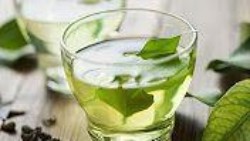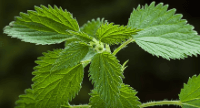Most people would prefer taking a natural DHT blocker for hair growth rather than Finasteride or Dutasteride. However, the latter two synthetic drugs are far more effective in regrowing hair, albeit with the possibility of worse side effects.

Nevertheless, natural dihydrotestosterone (DHT) blockers can significantly reduce high scalp dihydrotestosterone levels, and at least modestly help with hair growth. In this post, I will outline the most famous and effective natural DHT inhibitors to combat androgenetic alopecia. Some of these work by blocking 5-alpha-reductase enzyme activity, which converts testosterone to the DHT hormone.
I also ask you to submit your suggestions for other lesser known natural products that have scientific backing in reducing DHT levels. For example, a number of studies from Asia have found sea or marine based algae (such as Ecklonia cava) and other plants to be effective at reducing DHT levels via inhibition of 5α-reductase activity.
The Best Natural DHT Blockers

A number of natural herbs and plants have been proven to reduce DHT significantly. The extracts of some of these natural “medicines” seem to regularly appear in hair loss products such as the one on the left.
Below, I outline some natural DHT blocking ingredients that I have seen over and over again in various natural hair loss products that do not require a prescription. Many contain added ingredients to benefit hair growth, especially B-vitamins such as biotin and niacin.

Saw Palmetto Plant. Saw Palmetto (Serenoa repens). By far the most popular natural DHT blocker in the world. Saw palmetto extract is derived from the fruit of a specific variety of palm tree. A famous study found that 38% of people with male pattern hair loss who took saw palmetto experienced an increase in hair growth; versus 68% of those on Finasteride growing hair. The key ingredient in saw palmetto that is thought to counter DHT production is beta-sitosterol. If you are taking an oral saw palmetto supplement, typical daily dosages range from 160 mg to 320 mg. Note that even natural supplements can cause side effects in some people, so please consult a dermatologist before trying these products.
- Pygeum. A lesser known product derived from pygeum bark of an african plum tree. Pygeum africanum can reduce prostate size and urinary tract problems per one summary of various clinical trials. Most products that reduce the size of the prostate gland enlargement typically do so via reducing DHT levels, either directly or indirectly via 5α-Reductase.

Stinging Nettle (Urtica Dioica). Stinging nettle (Urtica dioica) or nettle root extract. A number of studies have found that this alternative treatment reduces benign prostatic hyperplasia (BPH), aka enlarged prostates.
- Pumpkin seed oil (PSO). A surprising ingredient that has been been shown to block the action of 5-alpha reductase and has antiandrogenic properties. Sometimes available as part of a DHT blocker oil.
Besides the earlier mentioned Propidren, another competing product is Folliform for men and women. Sometimes this product is cheaper at Walmart. Other well known natural oral DHT blocker brands include Advanced Trichology, DrFormulas, NuHair and Shen Min.
Your Ingredient Suggestions
What other natural products do you like that reduce DHT significantly? If you can find a number of scientific studies that support your suggestion, I will take your comment seriously. Several manufacturers of bestselling hair loss shampoos and supplements have asked me over the years to make ingredient recommendations to treat hair loss. I think they are serious about adding new natural products into their product recipe if there is sufficient evidence and reader interest in doing so.
Among other products that block DHT include specific varieties of:
- Seaweed, sea vegetables and alga (algae).
- Essential oils such as tea tree and rosemary.
- Mushrooms.
- Seeds such as flax and sesame.

Also thought to reduce DHT on the scalp include lycopene, soy, tea tree oil, green tea (via Epigallocatechin gallate aka EGCG), sterols, turmeric, ketoconazole and more. You will find most of the products mentioned in this section as ingredients in various shampoos and conditioners. Wikipedia has a lengthy list of 5α-reductase inhibitors.
Even drinking certain beverages such as black tea and lycopene rich juices (tomatoes, watermelons, carrots) is thought to modestly reduce DHT levels. Some vitamins and minerals can also naturally reduce DHT, albeit modestly. It should be noted that caffeine is unlikely to reduce dihydrotestosterone levels.
Topical DHT Blockers and Inhibitors
Most natural DHT blockers come in pill, tablet or capsule form and are taken orally or internally. However, recently, I have noticed some popular topical DHT blockers and inhibitors in solution or serum formats. Some even come in spray cans or bottles. Most contain saw palmetto as the key ingredient. I am not sure how effective these topical products are at blocking DHT, but some have numerous positive reviews and ratings. Key ingredient delivery is perhaps easier in comparison to topical finasteride.

One popular topical product on Amazon is Propidren serum by Hairgenics. Among its DHT blocking ingredients shown on the right include:
- Saw palmetto fruit berry.
- Beta-Sitosterol.
- Horsetail extract.
- Nettle extract.
- Fo-Ti root.
- Pygeum bark powder.
- Green tea extract.
Another highly rated product is an organic saw palmetto based serum that also contains an assortment of essential oils. The latter includes: pumpkin seed oil; moringa oil; baobab oil; blackberry seed oil; flaxseed oil; rosemary oil; peppermint essential oil; cedarwood essential oil; and oregano oil. There is some evidence that essential oils can help your hair become thicker.


